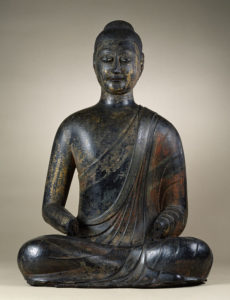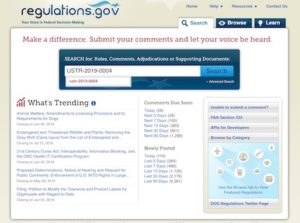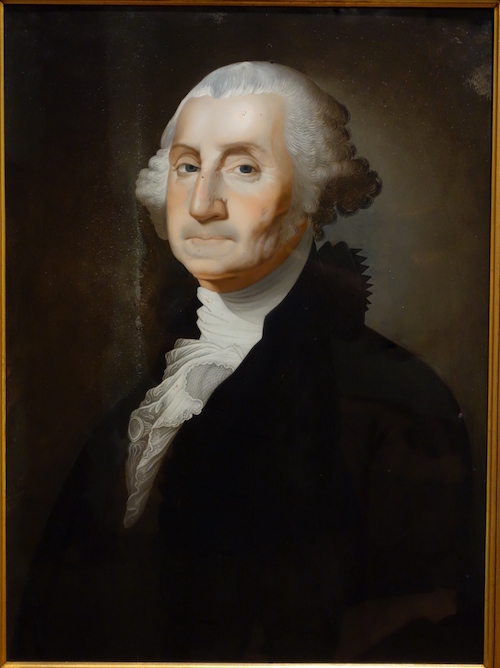The U.S. government is seeking once again to apply tariffs on Chinese art, despite an already existing ban on antique imports from China. Since 2009, Americans have been banned from importing any ancient art from China – ranging from the Paleolithic through the Tang period, and including monumental sculpture and wall art over 250 years of age. Contrary to popular belief, Chinese art dealers do not buy their art in China and export it to the U.S. The trade goes the other way, from the U.S. and other global markets to China, where the vast majority of moneyed collectors live.
The tariff proposal adds an additional ad valorem duty of up to 25 percent on products originally produced in China. Since the blockade on imports of antiques from China is already in place, the tariff will primarily affect Chinese antiquities imported from other countries. It will not affect the Chinese government, except to shrink the U.S. art market and give sellers and government-linked auction houses in China an even greater monopoly on the international market. However, if art and antiques are not removed from the 2019 tariff list, then antique Chinese artworks imported to the U.S. from Japan, Europe or the UK will be taxed with the 25% tariff.
Unless art dealers, collectors, and museums make their voices heard (See 2019-06-02 CCP to USTR Lighthizer re Section 301 Committee re Tariffs), all will be faced with punitive barriers to acquisition and donation. U.S. dealers and consumers will be disadvantaged in the global market, and Chinese dominance will increase.
Chinese goods imported from any country will be subject to the proposed tariffs

Canteen, bronze, China, 5th-4th century BC (Eastern Zhou), William T. / Henry Walters Collection, by bequest 1931, Walters Art Museum, Baltimore
The U.S. Trade Representative (USTR) has published a list of goods from China encompassing 3,805 different tariff categories with an annual trade value of $300 billion and is soliciting comments from the public on the proposed tariffs. The USTR Section 301 Committee will convene a public hearing on June 17, 2019, at the U.S. International Trade Commission in Washington, DC.
The antiques and collectible goods affected are:
- 9705.00.00 – Collections and collectors’ pieces of zoological, botanical, mineralogical, anatomical, historical, archaeological etc. interest.
- 9706.00.00 Antiques of an age exceeding one hundred years.
- Other art/cultural goods classifications including stamps, paintings, and sculptures numbering 9701- 9706 are also listed in the tariff proposal.
The public must submit requests to appear at the hearing by June 10, 2019 and written comments must be submitted by June 17. For details and who to contact, see the end of this article.
- June 10, 2019: Due date for filing requests to appear and a summary of expected testimony at the public hearing.
- June 17, 2019: Due date for submission of written comments.
- June 17, 2019: The Section 301 Committee public hearing at the U.S. International Trade Commission, 500 E Street SW, Washington, DC 20436, begins at 9:30 a.m.
- Seven days after the last day of the public hearing: Due date for submission of post-hearing rebuttal comments.

One of a pair of export bottles, porcelain with underglaze blue, 1660-1700, William T. or Henry Walters Collection, by bequest to Walters Art Museum, 1931.
Last September, the USTR exempted Chinese art and antiquities from tariffs that were applied to thousands of other Chinese goods, recognizing that in this instance, tariffs would help rather than punish the Chinese government. There were only a few submissions from U.S. art businesses, gallery organizations, and museums among the thousands of pleas for relief from U.S. industries affected by the proposed tariffs on other goods. However, Peter Tompa of Global Heritage Alliance, the only arts advocacy organization to be heard at the hearing, made a convincing presentation showing that the tariffs would damage the U.S., not China.
The USTR has stated that the increased tariffs were based on an investigation begun in August 2017 into “certain acts, policies, and practices of the Government of China related to technology transfer, intellectual property, and innovation.” (See 82 FR 40213). The Trade Representative determined that the policies and practices of China were unreasonable or discriminatory and that they restricted U.S. commerce.
In this second round of proposed tariffs, it is important that affected U.S. businesses, museums, and educational institutions make their voices heard.
Americans already cannot import antiques directly from China

Head of a Guardian King, China, 7th century (T’ang), Walters Art Museum, Baltimore Chinese Buddha Walters Art Museum, Baltimore.
The U.S. enacted import restrictions on Chinese art that were requested by the Chinese government under the Cultural Property Implementation in 2009. These import restrictions currently apply to goods including bronzes, stone sculptures, porcelains, ceramic wares, and ancient textiles. (The Chinese government originally requested that Chinese art up to 1912 be barred from U.S. entry.)
As a result, recent high-value sales in the U.S. are sourced from long-held and foreign collections of Chinese art. The U.S. imports Chinese art from Japan, the UK, and other nations where it circulated in the past. However, these goods must be correctly marked “country of origin China” and will be subject to the 25% tariff.
Chinese businesses and manufacturing will not suffer from a tariff on antiques. There is no way to “manufacture” authentic antiques. The only businesses harmed will be American ones, which will have to pay 25% more to import art from global markets in London, Paris and other art capitals where Chinese art is sold.
China’s domestic market expanded after the U.S. banned the importation of Chinese antiques in 2009. The auction market for art and antiques in mainland China experienced a 500% growth between 2009 and 2011, and by 2011, the Chinese auction market surpassed all other countries in the world with $9.3 billion in total sales value.[1] China’s internal trade in Chinese art and antiquities continues to be carefully orchestrated and controlled by its government. The Chinese government already makes it very difficult for foreign firms to sell antiquities in China.[2]
Historically, the U.S. has favored a free trade in art and antiques

Buddha, lacquer, China ca. 590. Acquired by Henry Walters, 1920, Walters Art Museum, Baltimore.
The proposed tariff on art and antiques is also contrary to longstanding U.S. cultural policy. Historically, U.S. policies emphasized the free trade of cultural property for the public good. For 90 years, the U.S. has encouraged the importation of modern and antique artworks, manuscripts, books, scientific, and other cultural objects by making them free of duty.
In 1930, Congress exempted antiquities and art objects made before 1830 from duty in order to encourage the free flow of artistic and cultural materials into the U.S.[3] Thus, the U.S. exempted antiques from duty even before the UNESCO Florence Agreement of 1952, which was also intended to “facilitate the free flow of educational, scientific and cultural materials by the removal of barriers that impede the international movement of such materials.”[4] The free trade policies of the past are still reflected in customs duties allowing free entry of art, antiques, books and manuscripts into the U.S.
The Educational, Scientific, and Cultural Materials Importation Act of 1966, Section 1(b) reinforced this public policy, providing that:
“The purpose of this Act is to enable the United States to give effect to the Agreement on the Importation of Educational, Scientific and Cultural Materials… with a view to contributing to the cause of peace through the freer exchange of ideas and knowledge across national boundaries.”[5]
This Act made importation of “antiques made prior to 100 years before their date of entry” duty free,[6] and enabled duty free importation of “[e]thnographic objects made in traditional aboriginal styles and made at least 50 years prior to the date of entry.”
Instructions from the USTR on how to send written comments or request to appear before the 301 Committee
 For requests to appear: To submit a request to appear at the hearing via www.regulations.gov, enter docket number USTR-2019-0004 on the home page and click `search.’ The site will provide a search-results page listing all documents associated with this docket. Find a reference to this notice and click on the link titled `comment now!’
For requests to appear: To submit a request to appear at the hearing via www.regulations.gov, enter docket number USTR-2019-0004 on the home page and click `search.’ The site will provide a search-results page listing all documents associated with this docket. Find a reference to this notice and click on the link titled `comment now!’
In the `comment’ field, include the name, address, email address, and telephone number of the person presenting the testimony. Attach a summary of the proposed testimony, and a pre-hearing submission if provided, by using the `upload file’ field. The file name should include both the name of the person who will be presenting testimony and the entity they represent. In addition, please submit a request to appear and a PDF of the summary of proposed testimony by email to 301investigation@ustr.eop.gov.
 In the subject line of the email, please include the name of the person who will be presenting testimony, followed by `request to appear.’ Please also include the name, address, email address, and telephone number of the person presenting testimony in the body of the email message.
In the subject line of the email, please include the name of the person who will be presenting testimony, followed by `request to appear.’ Please also include the name, address, email address, and telephone number of the person presenting testimony in the body of the email message.
For written comments and submissions: All submissions must be in English and sent electronically via www.regulations.gov. To submit comments via www.regulations.gov, enter docket number USTR-2019-0004 on the home page and click `search.’ The site will provide a search-results page listing all documents associated with this docket. Find a reference to this notice and click on the link titled `comment now!’ No hand-delivered submissions will be accepted.
[1] Artnet and Chinese Association of Auctioneers, Global Chinese Art Auction Market Report 2016 at 12 (2016). Between 2009 and 2011 auction sales of arts and antiques overseas had also expanded by 278%.
[2] The largest auction house in China is the Beijing Poly International Auction Co., which is part of a state-owned enterprise known predominantly for arms dealing. Deborah Lehr, China’s Art Market is Booming—Just Not for Foreigners, Huffington Post, Mar. 1. 2017, https://www.huffingtonpost.com/entry/chinas-art-market-is-booming-but-not-for-foreigners_us_58b6fb0de4b0563cd36f6399; Barbara Pollack, China’s Growing Auction Giant, Art News, Oct. 21, 2013, http://www.artnews.com/2013/10/21/chinas-growing-auction-giant/.
[3] The Harmonized Tariff Schedule for the U.S. Tariff Act of 1930 established the concept of an “antique” as a handcrafted object 100 years old or older. 19 U.S.C. ch. 4 (1930). The exemption from duty on antiques and archaeological materials is under the Harmonized Tariff Schedule of the United States Revision 7, ch. 97, § XXI (2019), (Works of Art, Collectors’ Pieces and Antiques, Subheading 9705.00.00 to 9706.00.00).
[4] UNESCO Agreement on the Importation of Educational, Scientific and Cultural Materials, adopted by the General Conference at its fifth Session, Florence, 17 June 1950, entered into force 1952 (“Florence Agreement”), 131 U.N.T.S. 25 (1950). The U.S. signed June 24, 1959 and ratified November 2, 1966. Declarations & Reservations: Protocol to the Agreement on the Importation of Educational, Scientific or Cultural Materials, with Annexes A to H 1976, UNESCO, adopted by the General Conference at its fifth Session, Florence, 17 June 1950, entered into force 1952 (“Florence Agreement”).
[5] The Educational, Scientific, and Cultural Materials Importation Act of 1966, Pub. L. No. 89-651, 80 Stat. 897 (1966).
[6] Id. at §4(b) (Works of Art, Antiques). Section 1(a) of Pub. L. 89–651, Oct. 14, 1966, 80 Stat. 897.
 George Washington, attributed to Foeiqua (Chinese), c. 1800 1805, reverse painting on glass New Britain Museum of American Art. Wikimedia Commons.
George Washington, attributed to Foeiqua (Chinese), c. 1800 1805, reverse painting on glass New Britain Museum of American Art. Wikimedia Commons. 

